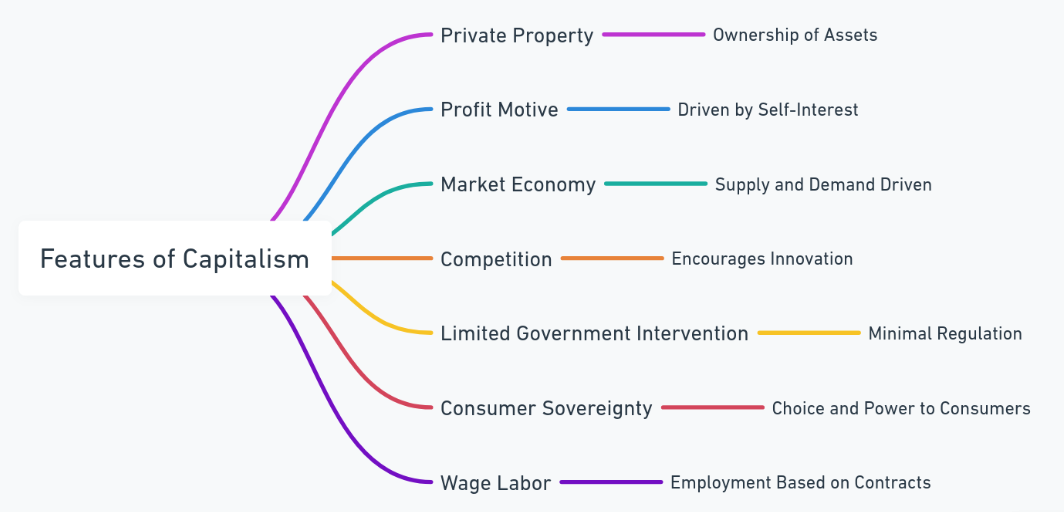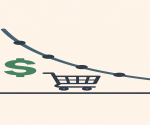A capitalist economy is one in which private individuals and businesses will ultimately own property as well as control resources used for production to achieve profits. In a capitalist economy, markets operate under pure supply and demand and with minimal government interference. Personal gain is what drives the economic engine behind this type of economy and leads to the creation of wealth and innovation. This system constitutes the backbone of many modern economies, such as the United States, Canada, and the United Kingdom.
What is a Capitalist Economy?
A capitalist economy, which is also often referred to as a free-market economy, is based on private ownership of the means of production. Thus, land, factories, and resources are owned by individuals or corporations that operate them for profit. A free market does not depend on government policies to decide who gets how much of which goods and services but rather on the free play of competition and market prices. What is central to this system is the profit motive, competition, and voluntary exchange. Normally, the role of the government in regulation would be limited to the protection of property rights, enforcement of contracts, and regulation of markets to prevent monopolies and to protect consumers.
In essence, capitalism thrives on the idea that economic freedom leads to economic efficiency and growth. Individuals, driven by self-interest, innovate and work hard, fostering overall economic development.
Features of Capitalism
Capitalism is characterized by several key features distinguishing it from other economic systems, such as socialism and communism. Below are some of the main features:
Two-Class System
In capitalism, society is divided into two primary classes:
- Capitalists: These are the private individuals or institutions who own the means of production, which can be factories and so on. They put up capital and hire labor to generate profit.
- Workers: Workers sell labor to capitalists for wages. Workers do not own production resources but provide the labor that is the prerequisite for production in an economy.
The interaction between these two classes forms the basis of economic transactions in a capitalist system.
Private Ownership
The most critical elements of a capitalist economy regard the private ownership of property and resources. Individuals and corporations have the right to own and control assets, such as land, machinery, and intellectual property, without interference from the government. That right to ownership on which people invest and innovate provides for everyone’s promise of gain.
Ownership also relates to profit. In the capitalist way of economics, it is only fair that those owning resources have a say in the profits they generate. This personal gain is an important motivator in any capitalist economy.
Self-Interest
Self-interest is the primary driving force of capitalism. Individuals and firms operate within their level of economic interest to maximize their wealth or utility. In fact, among the most outstanding thinkers in the development of capitalist thought was Adam Smith, who believed that self-interest leads to economic prosperity. Perhaps his most famous work was “The Wealth of Nations,” in which he introduced perhaps his greatest economic philosophy: the concept of the “invisible hand.” He said that if individuals are following their own self-interest, they contribute to the general welfare of society not because they intend to but because of the efficient utilization of resources.
Competition
Another foundation of capitalism is competition. In a system of capitalism, companies will emerge to compete with one another in attempting to offer the highest-quality products or services at the lowest prices available. This aspect of capitalism promotes innovation, productivity and efficiency as well as good customer service. Companies that fail to learn how to compete will be left at the risk of bankruptcy. This mechanism reinforces ongoing development and prosperity.
Competition would also have a beneficial effect on consumers in terms of lower price levels and variety. With cost-containment methods of production, firms are apt to offer customers better-quality products by developing more attractive choices that will draw in more customers to become their customers.

Market Mechanism
The market mechanism, which is otherwise called the price system, plays a crucial role in allocative resource deployment. Supply and demand forces determine prices. When the demand for a product goes up, the prices increase, indicating to the producers that they must raise supplies. When the demand level goes down, the prices decline, forcing the producers to reduce their production levels.
The market mechanism allows the efficient allocation of resources without central planning. Consumers are permitted to choose what to buy. Hence the producers react with ways to adjust their outputs according to such demands.
Adam Smith and John Maynard Keynes
Adam Smith and John Maynard Keynes are two pivotal figures in economic thought, representing different views within capitalism.
- Adam Smith, the father of modern capitalism, was one of its most ardent protagonists who advocated for the least possible intervention from the side of governments. He assumed that if left free and competitive the market, with driving forces like self-interest, would automatically create an environment of success.
- Keynes, however, understood little of the limitations of pure capitalism. He thinks government intervention is inevitable, especially in times when the economy needs to bounce back, for stabilizing markets, and employment promotion. This has greatly influenced modern capitalist economies, particularly fiscal policies in times of recession.
Freedom to Choose
The defining feature of capitalism is freedom of choice the consumer to choose what they want to buy, a worker where they can work, and an entrepreneur to choose what to sell. This freedom encourages freedom of choice and diversity in the market.
Entrepreneurs driven by the prospect of profit are free to organize new ventures; they can introduce new products and services that could satisfy consumers’ needs. As competition brews, better and more diversified goods and services will emerge.
Minimal Government Intervention
This doesn’t mean the government has no other role; it means it ensures markets function properly. This approach is often referred to as laissez-faire, which literally means “let it be.” The government will protect property rights, enforce contracts, and regulate monopolies to keep markets competitive.
However, most of today’s advanced capitalist economies are mixed economies in that the government intervenes in some measure to correct market failures, provide public goods, and pursue policies that reduce income disparities. Nevertheless, minimal intervention remains a bedrock tenet of capitalism.
Conclusion
In conclusion, a capitalist economy is founded upon private ownership, self-interest, competition and minimal government intervention. While this can prove effective for innovation, efficiency, and economic growth, though, at the cost of income inequality and market failures, the balance between forces of the market and government intervention remains an ongoing debate in circles among economists and policymakers.
Features of Capitalism FAQs
What are the main features of capitalism?
Capitalism is characterized by private ownership, competition, market mechanism, self-interest, minimal government intervention, and the freedom to choose.
How does competition benefit consumers?
Competition encourages businesses to improve their products and services and lower prices, benefiting consumers with better choices and affordability.
Who are Adam Smith and John Maynard Keynes?
Adam Smith is known for advocating free markets and minimal government intervention, while John Maynard Keynes argued for government intervention during economic downturns.
What role does the government play in a capitalist economy?
The government’s role in a capitalist economy is to protect property rights, enforce contracts, and ensure markets remain competitive, although it may intervene during crises.
What is the two-class system in capitalism?
The two-class system divides society into capitalists, who own the means of production, and workers, who sell their labor in exchange for wages.

